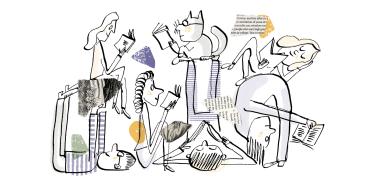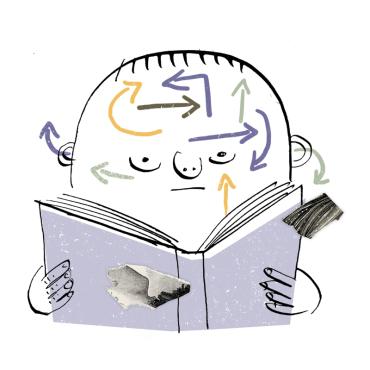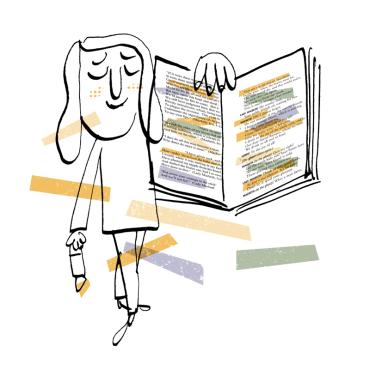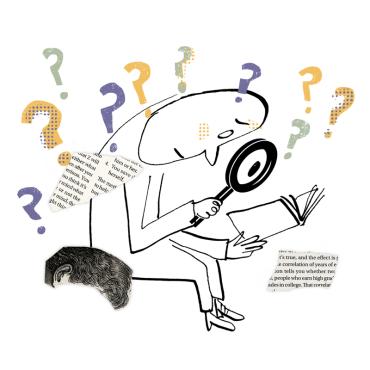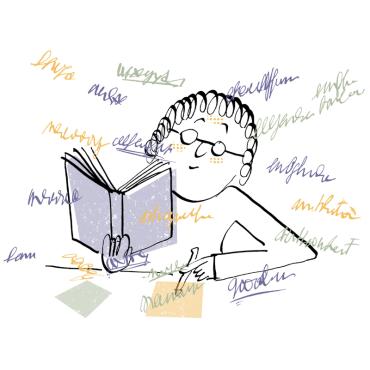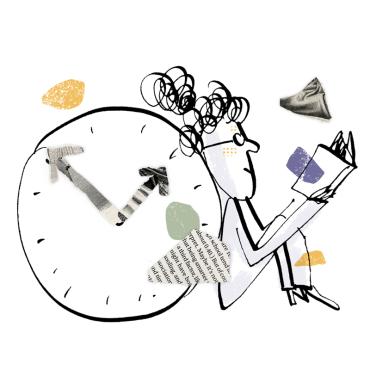It seems obvious why textbooks are hard to read. The material is dense; there’s a lot of information packed into relatively few words. Authors often feel obligated to give you a broad, complete understanding of a topic rather than to weave an interesting story from selected details. Teachers are ready to assign a textbook, even if it’s boring; it’s seen as a regrettable but unavoidable problem.
But there’s a more subtle reason that it’s hard to stay engaged when you read a textbook. To find out why, read this paragraph, one you might find in a typical high school textbook.
The Manhattan Project was the United States’ effort to produce a nuclear weapon, and it was the largest construction enterprise in the history of science. Because of its sensitive nature, a massive effort was made to keep the project secret. Famous scientists traveled under aliases; Enrico Fermi was known as Henry Farmer, for instance. And all telephone conversations at the test sites were monitored. Despite those efforts, historians agree that it probably would have been impossible to keep the secret if not for the fact that the project was of relatively small size.
Did you notice that the last sentence contradicted the first? Embedding a mistake or contradiction into a text and seeing whether readers notice it is a common research technique to measure comprehension. Readers are asked to judge each text on how well it’s written and explain their rating.
Readers are very likely to notice a word they don’t know. They are also very likely to notice if the grammar of a sentence is wrong. But they are much less likely to notice when two sentences contradict each other. Forty percent of high school students missed the contradiction in the paragraph above. To put it another way, if readers simply understand each sentence on its own, they figure they are doing what they’re supposed to do.
Coordinating meaning across sentences is crucial to reading comprehension, because sentences can take on quite different meanings depending on the surrounding context. For example, consider a simple sentence, “Maxim waved,” in different contexts:
Ann walked into the pizza parlor, looking for her friends. Maxim waved.
The boat slowly circled the wreckage, looking for survivors. Maxim waved.
“Oh, my God, that’s my husband!” Kate whispered. “Don’t do anything that would attract his attention!” Maxim waved.
In one way, the sentence always means the same thing (the physical act of waving by Maxim), but the more important meaning—why Maxim waved and the likely consequences of his action—is very different. It can be appreciated only if you interpret the sentence in light of what you’ve already read.
The same issue applies in a far more complex way to reading textbooks. Writers organize the material hierarchically, so readers often need to connect what they’re reading now to something they read a few pages ago. But readers expect a simple format. We first learn to read storybooks. Stories are easy to understand because the structure is simple and linear: A causes B, which causes C, and so on. Textbooks’ hierarchical format and content are more challenging, so you shouldn’t sit down to read a textbook and expect that the author will make your job easy. You need a different approach to reading such content.
When Reading to LearnWhat your brain will do: It will read the way you read for pleasure, because that's familiar to you and it's not obvious that it won't work. You'll read making minimal effort to coordinate ideas, trusting that either the writer will make the connections explicit and easy to follow. How to outsmart your brain: Use specialized strategies for comprehension that fit both the kind of material you're reading and the goals you have for reading it.
|
Learning by reading is a substantial challenge, but with a few strategies under your belt, you can be much more successful in connecting the ideas as the author hoped you will.
TIP 1—Don’t Do What Most People Do: Just Read and Highlight
Let’s start with the most common tactic people use when reading with the intention of learning. They open the book and start reading. When something strikes them as important, they mark it with a neon highlighter. They believe that the act of highlighting will help affix the information in their memory and that highlighting creates a ready-to-use study guide. Later, they believe, they can refresh their memory by rereading what they’ve highlighted.
This is a terrible plan. It does not address people’s habit of failing to coordinate meaning across sentences and paragraphs. How can you be sure that you are highlighting the most important information if your understanding is hit-or-miss in the first place? Furthermore, even if you understand everything quite well, how can you be sure that you are a good judge of what is important enough to highlight as you read the content of a topic you know little about for the first time?
Both problems—you may not understand as well as you think and you may judge importance poorly—suggest that people don’t highlight the most important information. Researchers have tested that prediction with a simple, clever method. They went to a college bookstore and bought 10 used copies of the textbook for each of three courses. If spotting the most important content were easy, everyone should have highlighted the same material. But the researchers found little overlap in what students had highlighted. That’s why I’ve used boldface type for the important points in this article (and the book it’s drawn from); I’ve done the highlighting for you.
Please note that this advice doesn’t mean “never highlight.” Highlighting might be fine if you are reading about a topic you already know a lot about. If you’ve been a political consultant for 20 years and you’re reading a briefing on a recently concluded statewide campaign, your deep knowledge of the topic means that you will read the document with good comprehension and your knowledge will also make you a good judge of what information in the document is important.
A college student reading the same document as part of a political science course lacks the necessary background knowledge, but there’s another reason the political consultant reads the document with better comprehension: she knows what to expect. She knows the type of information such a document usually contains, and she knows the function it’s meant to serve. The novice doesn’t.
If you have even a vague idea of what to expect when you read, that will make you read differently. You’ll notice and remember different details, for example. A chapter on the Human Genome Project, the effort to map all the genes in human DNA, might focus on any of several aspects of such a complex topic. It might describe the expected economic benefits to the pharmaceutical industry or the project’s impact on gene therapy. It might describe the politics of the government funding such a huge project. Knowing the author’s goal before you begin reading gives you a start on evaluating which ideas in the chapter are most important.
Thus, highlighting is not the only flaw in the “just read and highlight” approach. “Just read” is also a bad strategy, because you shouldn’t plunge into a text without some preparation.
Now let’s consider what you should do.
|
In a sentence: reading and highlighting is a poor strategy because it fails to provide a framework for understanding before you read and it leads you to decide that some material is more important than other material, even though you have little basis for that judgment. |
TIP 2—Use a Reading Strategy That Fits Your Goal
With a textbook or other difficult text, you can’t just start reading. You need to bring something to the process rather than wait for the author to intrigue you. At the same time, the advice “Read actively” is nearly useless. You may earnestly set the goal “I’m really going to think as I read, and I’m going to connect ideas,” but it’s just too easy for your attention to drift.
The solution is to set a concrete task to be completed as you read. The best known is called SQ3R, which has been around in various versions since the 1940s. SQ3R is an acronym for these steps:
Survey: Skim the reading, looking at the headings, subheadings, and figures. Get a rough idea of what it’s about. This is how you’ll determine, for example, that an article about the Human Genome Project is about its economic consequences, not the ethical implications of sequencing human DNA.
Question: Before you read, pose questions that you expect the reading to answer. Headings can be especially useful for this task; for example, if you see the heading “Marr’s Contribution to the Philosophy of Science,” the obvious question to ask is “What was Marr’s contribution to the philosophy of science?”
Read: Keeping in mind the rough idea of the article’s content you developed when you surveyed the reading, it’s time to actually read. And now you have a concrete task to be completed as you read: look for information that answers the questions you’ve posed.
Recite: When you’ve finished each section, recite what you’ve learned as if you were describing it to someone else. Summarize it and decide if it answers any of your questions.
Review: Reviewing is meant to be an ongoing process in which you revisit the content, focusing especially on the questions posed and the answers you derived.
Research confirms that using SQ3R improves comprehension, and it’s easy to see why. I’ve explained why you shouldn’t just plunge into a reading; if you first consider what it’s about and why you’re reading it, you will actually read it differently. The Survey and Question parts of SQ3R get you to do exactly that. I also emphasized that it’s essential to build meaning across sentences, and reading with the questions in mind also helps accomplish that.
The Recite step of SQ3R ought to help you pull your thoughts together and retain content, but even more, it’s a check of your comprehension. Remember that people can easily fool themselves into thinking they understand when they don’t. Reciting will help you better evaluate your comprehension.
The one drawback to the SQ3R method is that you may slip into “just reading” without thinking much. Here’s a trick that might help: after you’ve posed your questions (and before you start reading), place some blank Post-it notes in the text—maybe one at the end of each section. They’ll serve as visual reminders that you should stop, try to summarize the section you’ve just read, and think about whether the section answered any of the questions you posed.
SQ3R is useful, and it’s the best known of this sort of strategy, but there are others, including KWL (think about what you Know; what you Want to know; what you’ve Learned), SOAR (Set goals; Organize; Ask questions; Record your progress), and others. It’s no accident that most reading strategies have two important properties in common: they get you to think about your goal for reading before you start and connect the pieces of the reading by asking big-picture questions.
If these strategies seem like overkill, let me offer an alternative with just one step that may be an easy start to this kind of work. Instead of posing questions in advance, pose and try to answer questions as you’re reading, especially “Why?” questions in response to stated facts. For example, when you read, “The president can propose legislation, but a member of Congress must introduce it if it’s to become a bill,” you might ask, “Why must a member of Congress introduce it?” “Why?” questions tend to lead you to deeper principles and connections, in this case perhaps to the idea of the balance of powers among the three branches of the US government.
The advantage of this method is its flexibility—you don’t commit yourself to a set of questions before you’ve started reading. In addition, it’s easy to adapt this strategy to readings that tell you how to do something rather than telling you a bunch of facts. How-to information tends to occur in stages, so you can ask, “Why does this step come next?” The disadvantage of this method is that you can’t pose a question to yourself every time the author states a fact—that would slow you down too much—so effective question posing takes some practice.
Again, there’s no definitive evidence that one strategy is superior to another. What the evidence shows is that using a strategy is better than not using one.
|
In a sentence: Good reading strategies prompt you to think about the content and set concrete goals for what you're to learn before you read, and help you connect ideas as you read. |
TIP 3—Take Notes as You Read
Whenever I meet with a student who is struggling in one of my classes, I always ask her to bring her notes. Everyone has notes they’ve taken in lectures, but most people do not take notes on the readings. Surveys bear out my experience. People don’t take notes on readings because they figure that highlighting serves the same purpose. But we’ve been over why it doesn’t. Taking notes on readings serves the same functions as taking notes during a lecture: it helps keep you mentally on task, and the notes will help refresh your memory later.
How should you begin? In particular, how should you prep for taking notes? The same way you prep for reading: by posing questions at the start. But how can you craft good questions about a text you haven’t read? The author may give you a good overview in the first few paragraphs, or perhaps there are questions at the end of the reading that provide some guidance. Or maybe the instructor, God bless her, told you what she hoped you’d get out of the reading. Write these at the very top of your notes, so you can keep them in mind as you read.
If the reading includes headings and subheadings, you might write those in your notes; they can serve as a skeletal outline. As you read, complete the outline. For each subheading, write a summary and about three other statements. These statements might include, for example:
- An important qualification to the summary
- A comment on how this section relates to the main section
- How the section answers one of the questions you posed for the reading as a whole
- An implication of the summary for something else the author concluded
You should also include any new vocabulary terms and their definitions. As much as possible, use your own words, not the author’s. There’s no point in taking dictation; you need to manipulate the material mentally.
As you consider exactly what to record in your notes, you might think ahead to how you will use them. If you’ll later be tested, consider that there are different types of test questions, such as short-answer and essay questions. Each emphasizes different types of content. Answers to the former are necessarily short and often call for definitions, dates, or examples to be categorized. Essay exams, of course, pose broad questions, so you had better understand themes and how things connect. If you know how you will be tested, pay special attention to the content that’s vital for that type of assessment.
When you’ve finished reading and taking notes, you may be delighted to be through with the job. Actually, you’re not quite done. Once you’ve completed the reading, you should look over your notes to be sure you’re satisfied. Did you answer the questions you posed? Are you still convinced that they were the right questions? Do you think your notes are good enough that even if you set them aside for a few weeks, rereading them will enable you to recover all of your insights into the content?
Finally—and you don’t have to do it right now—if there’s a lecture associated with the reading, you should consider how the two relate. If you are virtuous and completed the assigned reading before the lecture, you can try to anticipate. If the lecture has passed, don’t let this task be forgotten.
|
In a sentence: Take notes on the thoughts generated by your reading strategy; doing so will help ensure that you don't mentally drift into casual reading, and the notes will, of course, be useful for reviewing later. |
TIP 4—Allocate Significant Time to Reading
It’s difficult to read texts on complex topics written by authors who are not afraid to bore their audience. What’s more, you’re taking multiple classes, and you also have work around the house (and possibly a job) to do. So if reading makes you feel overwhelmed, you should know that you’re not alone.
Most school-related tasks—giving a presentation, for example, or taking an exam—carry immediate, obvious consequences if you fail to prepare. But the cost of failing to read something you ought to is usually delayed, so that’s the task that is postponed or abandoned.
Some study guides suggest that that’s a good idea, and they offer methods to figure out which readings to neglect as well as tactics for skimming those you do take on. Let’s start by debunking a couple of common tricks meant to allow you to skip readings.
First, speed reading is not a thing. You can waggle your hand from the top to the bottom of the page, but you literally cannot read that fast. Lots and lots of studies have been conducted over the decades showing that people who claim to be speed reading are skimming, and as you’d expect, if you skim difficult, unfamiliar material, you won’t understand it very well.
Second, if the readings include learning aids such as chapter outlines, chapter previews and summaries, boldface or italicized terms, or practice test questions, don’t try to use these learning aids as a replacement for reading the text. The funny thing about these features is that there’s very good research evidence that they work. Publishing companies paid to have high-quality research conducted; researchers had people read textbook chapters (with or without the learning aids), and they found that people who used the learning aids understood and remembered more than those who did not.
But the psychologists Regan Gurung and David Daniel pointed out that students “in the wild” will not necessarily use such materials the same way they were used by students in the laboratory. Gurung and Daniel suggested that some students use learning aids not to supplement the reading but to avoid it. They read the summary, look at the boldface terms, and then try to answer the practice test questions to see whether they understand enough to skip the reading.
Now, everyone has times when their schedule backs up or something unexpected happens. I can understand doing selective skimming of a reading when your planning fails you. But planning to skip readings strikes me as foolish. I’ve seen study skills books in which the author encourages the reader to adopt this strategy for “secondary” readings. Guessing which readings will be the important ones is like trying to second-guess the stock market; it’s not very likely to pay off.
I suggest that you allocate “significant” time to reading. What does that mean in practical terms? In college, you’ll often hear “three hours of preparation for each hour in class.” A typical college course load calls for 12.5 hours of class time per week, so that rule of thumb means around another 37 hours of preparation outside class (which breaks down to 5.5 hours a day), totaling about 50 hours of work per week. So a lot, but nothing outrageous. That said, people vary in how quickly they read, and obviously some readings take longer to get through than others.
|
In a sentence: Reading textbooks and other difficult texts is hard work; be sure you schedule enough time to give it the attention and mental effort it requires. |
Although even a rough figure of how much time you’ll need is difficult to pin down, you should recognize that reading is the chief way that you will learn in college and beyond. It is worth reading carefully, both to learn now and to develop the knowledge, skills, and habits that will make you a successful reader in the future.
Daniel T. Willingham is a professor of cognitive psychology at the University of Virginia. He is the author of several books, including the bestseller Why Don’t Students Like School? This article is drawn with permission from his latest book, Outsmart Your Brain: Why Learning Is Hard and How You Can Make It Easy.
[Illustrations: Serge Bloch]

